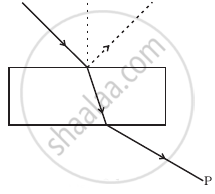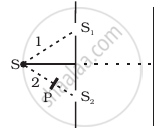Advertisements
Advertisements
प्रश्न
Discuss about Nicol prism.
उत्तर
Principle: Double Refraction
Construction:
- One of the most common forms of the Nicol prism is made by taking a calcite crystal which is a double refracting crystal with its length three times its breadth.
- It is cut into two halves along the diagonal so that their face angles are 72° and 108°.

Nicol Prism - The two halves are joined together by a layer of Canada balsam, a transparent cement.
- A ray of unpolarized light from a monochromatic source such as a sodium vapour lamp is incident on the face AC of the Nicol prism. Double refraction takes place and the ray is split into ordinary and extraordinary rays.
- They travel with different velocities.
- The refractive index of the crystal for the ordinary ray (monochromatic sodium light) is 1.658 and for the extraordinary ray is 1.486. The refractive index of Canada balsam is 1.523.
- Canada balsam does not polarise light.
- The ordinary ray is total internally reflected at the layer of Canada balsam and is prevented from emerging from the other face.
- The extraordinary ray alone is transmitted through the crystal which is plane polarised.
-
Uses of Nicol prism:
- It produces plane polarised light and functions as a polariser
- It can also be used to analyse the plane polarised light (i.e) used as an analyser.
-
Drawbacks of Nicol prism:
- Its cost is very high due to the scarcity of large and flawless calcite crystals
- Due to an extraordinary ray passing obliquely through it, the emergent ray is always displaced a little to one side.
- The effective field of view is quite limited
- Light emerging out of it is not uniformly plane polarised.
APPEARS IN
संबंधित प्रश्न
How does one demonstrate, using a suitable diagram, that unpolarised light when passed through a Polaroid gets polarised?
Show, with the help of a diagram, how unpolarised sunlight gets polarised due to scattering.
Two polaroids P1 and P2 are placed with their pass axes perpendicular to each other. An unpolarised light of intensity Io is incident on P1. A third polaroid P3 is kept in between P1 and P2 such that its pass axis makes an angle of 45° with that of P1. Determine the intensity of light transmitted through P1, P2 and P3
Show, via a suitable diagram, how unpolarised light can be polarised by reflection.
The refractive indices of glass and water w.r.t. air are 3/2 and 4/3 respectively. Determine the refractive index of glass w.r.t. water.
The refractive indices of water for red and violet colours are 1.325 and 1.334 respectively.
Find the difference between the velocities of rays for these two colours in water. (c = 3 × 108 m/s)
A ray of light passes from a vacuum to a medium of refractive index (μ). The angle of
incidence is found to be twice the angle of refraction. The angle of incidence is _______.
A) `cos^(-1)(mu/2)`
B) cos−1(μ)
C) `2 cos^(-1) (mu/2)`
D) `2 sin^(-1) (mu/2)`
State two uses of Polaroid.
With the help of an experiment, state how will you identify whether a given beam of light is polarised or unpolarized?
What does a polaroid consist of? How does it produce a linearly polarised light?
Green light is incident at the polarising angle on a certain transparent medium. The angle of refraction is 30° . Find
(i) polarising angle, and
(ii) refractive index of the medium.
A ray of ordinary light is travelling in air. It is incident on air glass pair at a polarising angle of 56°. Find the angle of refraction in glass.
Discuss polarisation by selective absorption.
What is double refraction?
Mention the types of optically active crystals with example.
An unpolarised light of intensity 32 Wm-2 passes through three Polaroids such that the axes of the first and the last Polaroids are at 90°. What is the angle between the axes of the first and middle Polaroids so that the emerging light has an intensity of only 3 Wm-2?
Consider a light beam incident from air to a glass slab at Brewster’s angle as shown in figure. A polaroid is placed in the path of the emergent ray at point P and rotated about an axis passing through the centre and perpendicular to the plane of the polaroid.

Figure shown a two slit arrangement with a source which emits unpolarised light. P is a polariser with axis whose direction is not given. If I0 is the intensity of the principal maxima when no polariser is present, calculate in the present case, the intensity of the principal maxima as well as of the first minima.

To ensure almost 100 per cent transmissivity, photographic lenses are often coated with a thin layer of dielectric material. The refractive index of this material is intermediated between that of air and glass (which makes the optical element of the lens). A typically used dielectric film is MgF2 (n = 1.38). What should the thickness of the film be so that at the center of the visible spectrum (5500 Å) there is maximum transmission.
